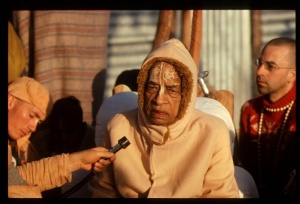SB 3.4.8

A.C. Bhaktivedanta Swami Prabhupada
TEXT 8
- vāma ūrāv adhiśritya
- dakṣiṇāṅghri-saroruham
- apāśritārbhakāśvattham
- akṛśaṁ tyakta-pippalam
SYNONYMS
vāme — on the left; ūrau — thigh; adhiśritya — placed on; dakṣiṇa-aṅghri-saroruham — the right lotus foot; apāśrita — taking rest against; arbhaka — young; aśvattham — banyan tree; akṛśam — cheerful; tyakta — having left; pippalam — household comforts.
TRANSLATION
The Lord was sitting, taking rest against a young banyan tree, with His right lotus foot on His left thigh, and although He had left all household comforts, He looked quite cheerful in that posture.
PURPORT
According to Śrīla Viśvanātha Cakravartī Ṭhākura, the Lord's sitting posture—keeping His back against the newly grown banyan tree—is also meaningful. Aśvattha, the banyan tree, is so called because the tree does not die very quickly; it continues to live for many, many years. His legs and their energies are the material ingredients, which are five in all: earth, water, fire, air and sky. The material energies represented by the banyan tree are all products of His external potency and are therefore kept to His back. And because this particular universe is the smallest of all, the banyan tree is therefore designated as small, or as a child. Tyakta-pippalam indicates that He had now finished His pastimes in this particular small universe, but since the Lord is absolute and eternally blissful, there is no difference between His leaving or accepting something. The Lord was now prepared to leave this particular universe and go into another, just as the sun rises on one particular planet and sets in another simultaneously but does not change its own situation.